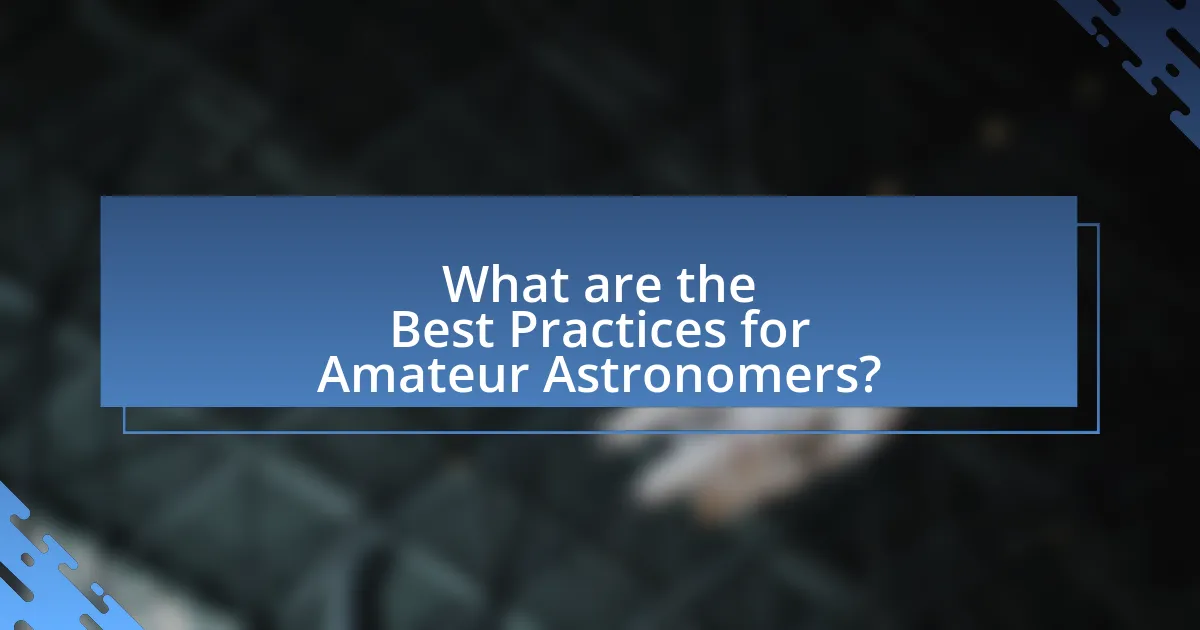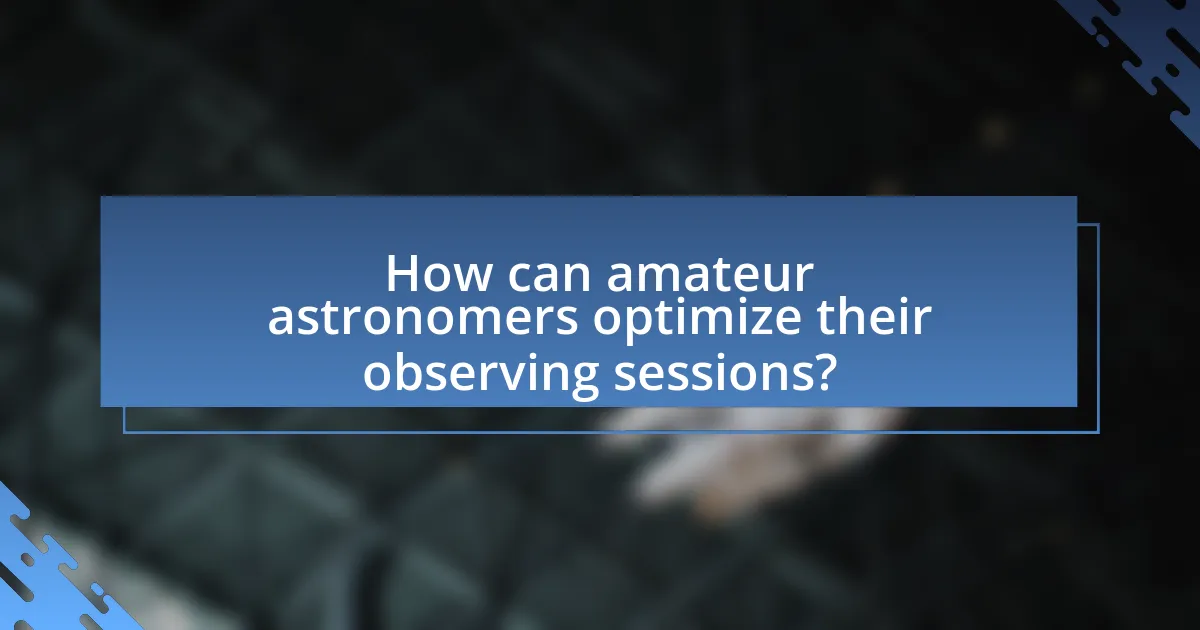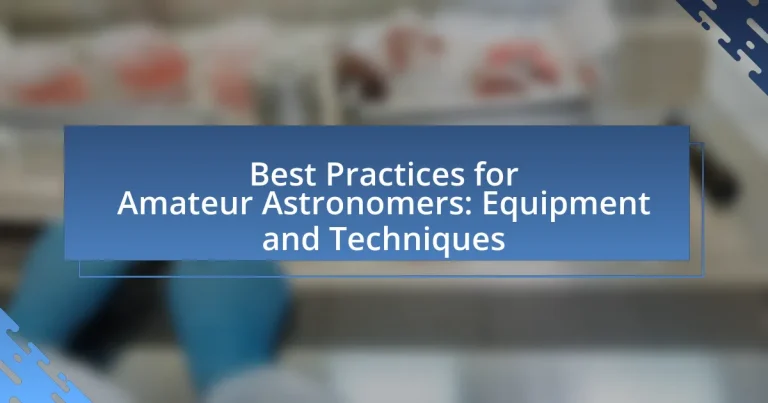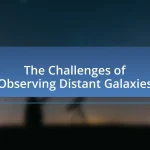The article focuses on best practices for amateur astronomers, emphasizing the importance of quality equipment, understanding celestial mechanics, and maintaining a regular observing schedule. It provides guidance on selecting appropriate telescopes based on interests and budget, as well as techniques to enhance the stargazing experience, such as using star charts and choosing dark locations. Additionally, the article addresses common challenges faced by amateur astronomers, including light pollution and equipment maintenance, while offering practical tips for successful observations and continuous learning in the field of astronomy.

What are the Best Practices for Amateur Astronomers?
The best practices for amateur astronomers include using quality equipment, understanding celestial mechanics, and maintaining a regular observing schedule. Quality equipment, such as telescopes with appropriate aperture sizes and mounts, enhances the viewing experience and allows for better observation of celestial objects. Understanding celestial mechanics, including the movement of planets and stars, helps amateur astronomers predict when and where to observe specific phenomena. Maintaining a regular observing schedule, ideally during clear nights away from light pollution, increases the chances of successful observations. These practices are supported by the experiences of seasoned astronomers who emphasize the importance of preparation and consistency in amateur astronomy.
How can amateur astronomers effectively choose their equipment?
Amateur astronomers can effectively choose their equipment by assessing their specific interests, budget, and experience level. Identifying whether they are more inclined towards planetary observation, deep-sky imaging, or astrophotography helps narrow down the type of telescope or binoculars needed. For instance, a beginner might opt for a simple refractor telescope, while more experienced astronomers may require advanced models with larger apertures for better light-gathering capabilities.
Budget considerations are crucial; entry-level telescopes can range from $100 to $500, while high-end models can exceed $2,000. Additionally, understanding the importance of accessories such as eyepieces, mounts, and filters can enhance the overall experience. Researching reputable brands and reading reviews can provide insights into the reliability and performance of different equipment options.
Ultimately, joining local astronomy clubs or online forums can offer valuable advice and firsthand experiences from other amateur astronomers, aiding in informed decision-making.
What factors should be considered when selecting a telescope?
When selecting a telescope, key factors to consider include aperture size, mount type, portability, and budget. Aperture size directly affects light-gathering ability and image clarity; larger apertures provide better views of celestial objects. The mount type, whether altazimuth or equatorial, influences ease of use and tracking capabilities. Portability is essential for amateur astronomers who may need to transport their equipment to different locations for optimal viewing. Finally, budget constraints determine the quality and features of the telescope, with a wide range of options available to suit different financial situations.
How do different types of telescopes compare for amateur use?
Different types of telescopes, including refractors, reflectors, and compound telescopes, offer varying advantages for amateur use. Refractors provide clear images and require minimal maintenance, making them ideal for beginners; however, they can be more expensive per inch of aperture. Reflectors, on the other hand, are cost-effective for larger apertures and are excellent for deep-sky observations, but they require regular collimation and maintenance. Compound telescopes combine features of both refractors and reflectors, offering versatility and compact designs, which can be beneficial for amateur astronomers who want a balance between portability and performance. Each type has distinct characteristics that cater to different preferences and observing goals among amateur astronomers.
What techniques can enhance the stargazing experience?
Techniques that can enhance the stargazing experience include using a star chart or stargazing app, employing binoculars or a telescope, and choosing a dark location away from light pollution. Utilizing a star chart or app helps identify constellations and celestial objects, making the experience more engaging and informative. Binoculars or telescopes provide a closer view of planets and deep-sky objects, significantly improving visibility. Selecting a dark location is crucial, as light pollution can obscure many celestial features; studies show that stargazing in areas with minimal artificial light can reveal thousands more stars than in urban settings.
How does understanding celestial navigation improve observation?
Understanding celestial navigation enhances observation by providing a framework for accurately locating celestial bodies in the night sky. This knowledge allows amateur astronomers to effectively use coordinates, such as right ascension and declination, to pinpoint stars and planets, improving their ability to track celestial movements. Historical practices, such as those used by ancient mariners, demonstrate that celestial navigation relies on precise measurements of celestial objects, which can be applied to modern observational techniques. By mastering these navigation skills, amateur astronomers can significantly increase their observational accuracy and efficiency.
What are the best methods for tracking celestial objects?
The best methods for tracking celestial objects include using telescopes equipped with motorized mounts, employing star trackers, and utilizing software applications for celestial navigation. Motorized mounts, such as equatorial mounts, automatically adjust to the movement of celestial bodies, allowing for precise tracking. Star trackers, which are devices that align with the stars, provide real-time positioning data to maintain focus on objects. Additionally, software applications like Stellarium and SkySafari offer detailed star maps and tracking capabilities, enhancing the amateur astronomer’s ability to locate and follow celestial objects effectively. These methods are widely recognized in the astronomy community for their accuracy and ease of use.

How can amateur astronomers optimize their observing sessions?
Amateur astronomers can optimize their observing sessions by planning ahead, using appropriate equipment, and selecting ideal locations. Planning involves checking weather conditions, moon phases, and celestial events to ensure optimal visibility. Utilizing equipment such as telescopes with suitable aperture sizes and quality eyepieces enhances the clarity of observations. Additionally, choosing dark-sky locations away from light pollution significantly improves the visibility of celestial objects, as studies show that light pollution can reduce the visibility of stars by up to 90%. By combining these strategies, amateur astronomers can maximize their observational experiences.
What are the best practices for planning an observing night?
The best practices for planning an observing night include selecting a suitable location, checking weather conditions, and preparing equipment in advance. A suitable location should be away from light pollution, ideally at a high elevation, to enhance visibility of celestial objects. Checking weather conditions is crucial; clear skies and minimal atmospheric turbulence are essential for optimal viewing. Preparing equipment involves ensuring telescopes and binoculars are in working order, bringing necessary accessories like star charts, and having a plan for the objects to observe. These practices are supported by the fact that many amateur astronomers report significantly improved experiences when they meticulously plan their observing sessions, as documented in various astronomy guides and community forums.
How does weather impact astronomical observations?
Weather significantly impacts astronomical observations by affecting visibility and atmospheric conditions. Factors such as cloud cover, humidity, and atmospheric turbulence can obstruct or distort the light from celestial objects, making it difficult to obtain clear images or accurate data. For instance, clouds can completely block the view of stars and planets, while high humidity can lead to increased atmospheric scattering, reducing clarity. Additionally, turbulent air layers can cause stars to twinkle, complicating precise measurements. Studies have shown that optimal observing conditions typically occur on clear, dry nights with stable atmospheric conditions, which are essential for high-quality astronomical data collection.
What tools can assist in planning for celestial events?
Astronomy software and mobile applications are essential tools for planning celestial events. Programs like Stellarium and SkySafari provide real-time simulations of the night sky, allowing users to identify celestial objects and events such as meteor showers, eclipses, and planetary alignments. These tools often include features like customizable location settings and event notifications, enhancing the planning experience for amateur astronomers. Additionally, websites like Time and Date offer detailed calendars and visibility charts for celestial events, ensuring accurate and timely information for observers.
How can amateur astronomers maintain their equipment?
Amateur astronomers can maintain their equipment by regularly cleaning optical surfaces, checking alignment, and storing gear properly. Cleaning involves using appropriate materials, such as microfiber cloths and lens cleaning solutions, to avoid scratches and damage. Regularly checking the alignment of telescopes ensures optimal performance, as misalignment can lead to poor image quality. Proper storage in a dry, temperature-controlled environment protects equipment from humidity and temperature fluctuations, which can cause damage over time. These practices help extend the lifespan and functionality of astronomical equipment.
What are the essential maintenance tasks for telescopes?
The essential maintenance tasks for telescopes include regular cleaning of optical surfaces, checking and adjusting alignment, lubricating moving parts, and inspecting for any signs of wear or damage. Cleaning optical surfaces, such as lenses and mirrors, should be done with appropriate materials to avoid scratches, ensuring clear images. Checking and adjusting alignment, known as collimation, is crucial for optimal performance, as misalignment can lead to distorted views. Lubricating moving parts, like focusers and mounts, helps maintain smooth operation and prevents mechanical issues. Regular inspections for wear or damage, including checking for rust or corrosion, ensure the longevity and reliability of the telescope.
How can one properly store astronomical equipment?
To properly store astronomical equipment, one should keep it in a dry, temperature-controlled environment, ideally in a padded case or dedicated storage cabinet. This prevents moisture damage and protects sensitive components from dust and physical impact. For example, telescopes should be stored with lens caps on to avoid scratches, and eyepieces should be kept in their original containers to prevent dust accumulation. Additionally, using silica gel packets can help absorb any excess humidity, further safeguarding the equipment. Proper storage practices extend the lifespan of astronomical tools and ensure optimal performance during use.

What common challenges do amateur astronomers face?
Amateur astronomers commonly face challenges such as light pollution, equipment limitations, and lack of experience. Light pollution significantly hampers visibility of celestial objects, making it difficult to observe faint stars and galaxies; studies indicate that over 80% of the world’s population lives under light-polluted skies. Equipment limitations often arise from budget constraints, leading to suboptimal telescopes and accessories that may not perform well for advanced observations. Additionally, lack of experience can result in difficulties with star identification, navigation, and understanding complex astronomical phenomena, which can be mitigated through community engagement and educational resources.
How can light pollution affect astronomical observations?
Light pollution significantly hampers astronomical observations by obscuring celestial objects and reducing the contrast between stars and the night sky. This interference occurs because artificial lighting scatters in the atmosphere, creating a bright background that diminishes the visibility of faint astronomical phenomena. Studies indicate that over 80% of the world’s population lives under light-polluted skies, which limits the ability to observe stars, planets, and other celestial bodies. For instance, the International Dark-Sky Association highlights that light pollution can reduce the visibility of stars by up to 90% in urban areas, severely impacting both amateur and professional astronomers’ ability to conduct observations and gather data.
What strategies can be employed to minimize light pollution effects?
To minimize light pollution effects, strategies include using shielded lighting, implementing outdoor lighting regulations, and promoting the use of low-intensity, warm-colored lights. Shielded lighting directs light downward, reducing skyglow and glare, which is essential for preserving night sky visibility for amateur astronomers. Outdoor lighting regulations can limit excessive brightness and encourage the use of fixtures that minimize light spill. Additionally, warm-colored lights, such as those with a color temperature below 3000 Kelvin, are less disruptive to nocturnal wildlife and human circadian rhythms, making them a preferable choice for outdoor illumination. These strategies collectively contribute to a clearer night sky, enhancing the observational experience for amateur astronomers.
How can amateur astronomers find dark sky locations?
Amateur astronomers can find dark sky locations by utilizing resources such as light pollution maps, astronomy apps, and local astronomy clubs. Light pollution maps, like the one provided by the International Dark-Sky Association, visually represent areas with minimal artificial light, helping astronomers identify suitable sites. Astronomy apps, such as SkySafari or Dark Sky Finder, offer real-time data on light pollution levels and can guide users to nearby dark sky areas. Additionally, joining local astronomy clubs allows amateur astronomers to connect with experienced members who can share knowledge about optimal viewing locations based on firsthand experience.
What troubleshooting tips can help resolve common issues?
To resolve common issues in amateur astronomy, check the alignment of your telescope, as misalignment can lead to difficulty in locating celestial objects. Ensure that the finderscope is properly aligned with the main telescope; this can be verified by centering a distant object in the finderscope and then checking its position in the main scope. Additionally, inspect all connections and cables for any loose or damaged components, as these can affect the performance of electronic mounts and cameras. Regularly clean the optics with appropriate materials to prevent dust and smudges from degrading image quality. Lastly, consult user manuals for specific troubleshooting steps related to your equipment, as they often contain valuable information tailored to your device.
How can one address alignment problems with telescopes?
To address alignment problems with telescopes, one should perform a thorough collimation process, which involves adjusting the optical elements to ensure they are properly aligned. This can be achieved by using a collimation tool, such as a laser collimator or a collimation cap, to check and adjust the alignment of the primary and secondary mirrors. Proper collimation is essential for optimal image quality and is supported by the fact that misalignment can lead to blurred images and reduced light-gathering efficiency, as noted in various astronomy guides. Regular checks and adjustments, especially after transporting the telescope, can help maintain alignment and improve overall performance.
What should be done if equipment malfunctions during an observation?
If equipment malfunctions during an observation, the first step is to immediately cease using the faulty equipment to prevent further damage or safety hazards. Next, the observer should assess the nature of the malfunction, checking for common issues such as loose connections, low battery power, or software errors. If the problem is minor and can be resolved quickly, such as tightening a cable or replacing a battery, the observer should proceed with those fixes. If the issue is more complex, the observer should document the malfunction and seek assistance from experienced peers or consult the equipment’s manual for troubleshooting guidance. This approach is supported by the fact that many amateur astronomers encounter similar issues and often rely on community resources and manuals for effective problem-solving.
What are some practical tips for successful amateur astronomy?
To achieve successful amateur astronomy, start by selecting a dark location away from city lights to minimize light pollution, which significantly enhances visibility of celestial objects. Additionally, invest in a quality telescope or binoculars suited for your level of experience; for instance, a beginner-friendly telescope can provide clear views of the moon and planets. Familiarize yourself with star charts or astronomy apps to identify constellations and celestial events, as this knowledge will improve your observational skills. Regularly practice patience and allow your eyes to adjust to the darkness, which can take about 20-30 minutes, to maximize your viewing experience. Engaging with local astronomy clubs can also provide valuable insights and opportunities for shared observations, enhancing your learning and enjoyment of the hobby.
How can joining local astronomy clubs enhance the experience?
Joining local astronomy clubs enhances the experience by providing access to shared resources, expert guidance, and community engagement. Members benefit from collective knowledge, allowing them to learn about equipment and techniques more effectively than studying alone. For instance, clubs often organize star parties, workshops, and lectures, which facilitate hands-on learning and networking with experienced astronomers. Research indicates that participation in such clubs can significantly improve observational skills and deepen understanding of astronomical concepts, as members can share insights and experiences that enrich their learning journey.
What resources are available for continuous learning in astronomy?
Numerous resources are available for continuous learning in astronomy, including online courses, textbooks, podcasts, and astronomy clubs. Online platforms like Coursera and edX offer courses from universities, while textbooks such as “Astronomy: A Self-Teaching Guide” provide foundational knowledge. Podcasts like “StarTalk” and “Astronomy Cast” deliver insights from experts, and local astronomy clubs facilitate hands-on experience and community engagement. These resources collectively support ongoing education and skill development in the field of astronomy.


